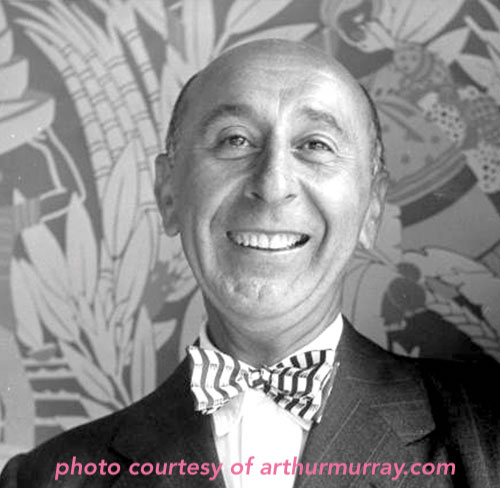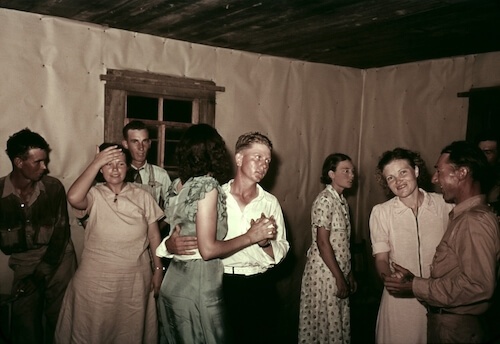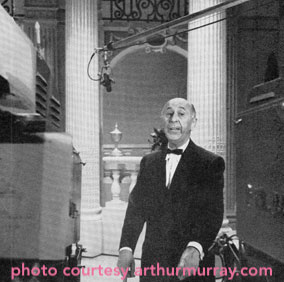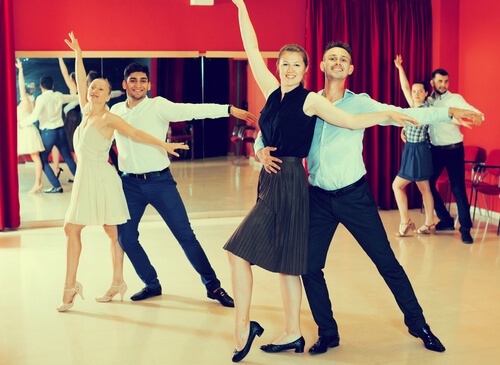 Whether you’re a star student at one of our dance classes or this is your first time seeing the name Arthur Murray in your life… you may be wondering: Who is this Arthur Murray character? Especially if you’ve done a little digging, you’ll notice that there are more than 260 Arthur Murray dance studios all over the world!
Whether you’re a star student at one of our dance classes or this is your first time seeing the name Arthur Murray in your life… you may be wondering: Who is this Arthur Murray character? Especially if you’ve done a little digging, you’ll notice that there are more than 260 Arthur Murray dance studios all over the world!
His name might sound familiar, but few people realize just how important Mr. Murray was to the social dance movement that took America by storm in the 20th century. To help give you some context next time you step onto one of our New Jersey dance floors, we thought we would give you a little history lesson on the man who made dancing possible for so many people. You may be relieved to know that Arthur Murray was also not-so-great at dancing when he first started, too.
Who is Arthur Murray?
 It all started in 1909, when a lanky kid named Arthur Murray learned a couple dance moves from a friend. He was self-conscious, but the more he danced, the more confident he felt. So he started dancing at neighborhood weddings, where would find willing partners to help him practice his moves. Then, when he was 17 years old (in 1912), Mr. Murray won his first dance contest at Grand Central Palace and began teaching dance there part-time.
It all started in 1909, when a lanky kid named Arthur Murray learned a couple dance moves from a friend. He was self-conscious, but the more he danced, the more confident he felt. So he started dancing at neighborhood weddings, where would find willing partners to help him practice his moves. Then, when he was 17 years old (in 1912), Mr. Murray won his first dance contest at Grand Central Palace and began teaching dance there part-time.
As his love for dance grew, so did his passion for wanting to spread the movement to more and more people. Mr. Murray realized how wonderful dancing was, and how anyone could do it with a little practice, so he became determined to find a business plan that could work.
His first try at teaching dancing to the masses was a mail-order program.
Arthur Murray Dance Studios
 Mr. Murray’s next dance business idea was one that involved franchising. He began this business in 1925. He would train dance teachers from the Statler Hotel chain, and those instructors would give lessons at various hotels. Mr. Murray would keep some of these profits.
Mr. Murray’s next dance business idea was one that involved franchising. He began this business in 1925. He would train dance teachers from the Statler Hotel chain, and those instructors would give lessons at various hotels. Mr. Murray would keep some of these profits.
Then, in 1938, Mr. Murray expanded this business into what we know as his dance studio franchises today. The first Arthur Murray dance studio opened in Minneapolis, Minnesota, with the slogan, “If you can walk, we can teach you how to dance.”
If that slogan isn’t enough to inspire you to sign up for a free dance class today, you must be crazy! It worked back then, too. Eventually, Mr. Murray became a beacon of sorts for social dancing in America. People were falling in love with dancing just as he had.
His dance idea was working—it even lasted through two World Wars and the Great Depression!
The Arthur Murray Effect
 By the time the 1950’s rolled around, Mr. Murray was a regular celebrity. As the interest in Latin dancing grew, so did his business. So much so, that from 1950 to 1960, he even had his own TV show! “The Arthur Murray Party” aired on every major television network at the time, and the show featured celebrities and musical guests. This “Party” was inspired by the practice parties at Arthur Murray dance studios—a tradition we still bring to each of our dance studio locations today.
By the time the 1950’s rolled around, Mr. Murray was a regular celebrity. As the interest in Latin dancing grew, so did his business. So much so, that from 1950 to 1960, he even had his own TV show! “The Arthur Murray Party” aired on every major television network at the time, and the show featured celebrities and musical guests. This “Party” was inspired by the practice parties at Arthur Murray dance studios—a tradition we still bring to each of our dance studio locations today.
His love for dancing caught like wildfire once people realized they could dance too. Social dancing helped people meet potential partners and simply enjoy life. When Mr. Murray eventually retired in 1964, he had more than 3,560 dance studios bearing his name.
The Arthur Murray Difference
 Though Mr. Murray passed away in 1991, his dancing legacy lives on and thrives. Perhaps the most important lesson he taught was that anyone can dance if they can walk. No matter how uncoordinated or shy you may be, with just a little help, you can become a dancing machine. And once people got over their nervousness and doubts, they got hooked on all the incredible benefits social dancing has to offer.
Though Mr. Murray passed away in 1991, his dancing legacy lives on and thrives. Perhaps the most important lesson he taught was that anyone can dance if they can walk. No matter how uncoordinated or shy you may be, with just a little help, you can become a dancing machine. And once people got over their nervousness and doubts, they got hooked on all the incredible benefits social dancing has to offer.
We are proud to spread the love of dance to so many people, thanks to Mr. Murray, and we can’t help but think he’d be so happy to see all of our students shaking a leg more than 100 years after he started his dance studios.
Snag your free first lesson today if you’re ready to try dancing for yourself. It’s what Mr. Murray would want.
{{cta(‘a7d6e4e1-a911-4f2b-8b43-6210da6d93fb’)}}

Leave a Reply